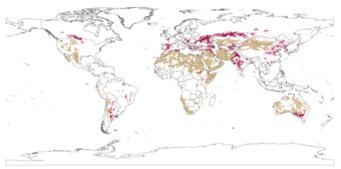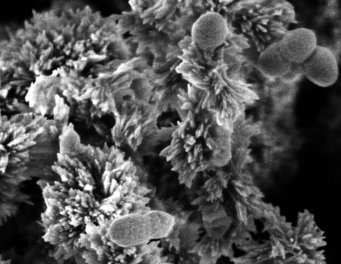Soil bacteria influence atmospheric self-cleaning
Bacteria in the soil release gaseous nitrous acid directly into the air
An international team of researchers from the Max Planck Institute for Chemistry in Mainz found out that bacteria in the upper-most soil layer release considerable amounts of hydrogen nitrite, better known as nitrous acid or HONO, into the air in gaseous form. The gas decomposes rapidly under sunlight into nitrogen monoxide and hydroxyl radicals. The latter clean the air as they oxidize and thus eliminate various pollutants. The research team´s findings offer an explanation as to why more HONO is measured in the atmosphere than it would be expected from the known sources.
Some time ago, scientists from the Max Planck Institute for Chemistry proved that HONO, i.e. nitrous acid, may be released from soil. A new study by the Mainz Institute now reveals that soil bacteria also release the gas directly into the air and thereby influence the cleaning of the atmosphere and the global nitrogen cycle.

“Two years ago, we discovered together with colleagues that the gas escapes from soils”, explains Ivonne Trebs, group leader at the Max Planck Institute for Chemistry. At that time, the researchers concluded that the more nitrite ions the soil contains and the more acidic it is the more HONO is released from soil. Under these conditions, nitrous acid is formed from soil nitrite and enters the air in gaseous form. “This simple, chemical formation pathway is logical, but had not been taken into account before”, says Ivonne Trebs.
Robert Oswald and Michael Ermel, doctoral candidates with Ivonne Trebs, already speculated at that time that bacteria in soil could also release HONO directly. Microbes that consume ammonia and are thus particularly comfortable in a neutral to slightly alkaline environment have already been known for a long time. However, microbiologists and geoscientists have thought up to now that they would only convert ammonia to nitrite which dissolves in the soil. The young researchers from Mainz now brought into play that the microbes also produce hydrogen nitrite, which they release directly into the air.
In order to verify their assumption, the scientists investigated soil samples from 17 different ecosystems in the laboratory. Most of the samples were obtained from collaborating research groups all over the world. “We examined soil samples from a Rhine-Hessian field as well as samples from a stone desert in China and a eucalyptus forest in Australia,” says the environmental scientist Trebs.
Global HONO emissions are linked to NO emissions

For each soil sample they determined how much HONO and how much nitrogen monoxide (NO) are released. Bacterial emissions of NO were already well known. “These emissions are quantified rather well worldwide since NO is also an important trace gas and influences many chemical reactions, such as the formation of ozone in the atmosphere,” explains Thomas Behrendt, who measures the NO emissions from soils at the Max Planck Institute. “We have now discovered that neutral and alkaline soils can release as much HONO as NO, which allows deducing the direct HONO emissions from the known NO emissions of the soil bacteria.”
The essential clues for direct bacterial HONO formation, however, came from a simple experiment: the researchers compared natural soil samples with samples in which the bacteria were killed. The HONO emissions from untreated soil samples were four times higher than from the sterilized soils. “HONO is produced by bacteria which exist in the upper-most soil layer and oxidize ammonia”, says Michael Ermel. In order to confirm this, the chemist also produced a simple kind of artificial soil made from glass beads and added ammonia-oxidizing bacteria. The sample with the bacteria released four times as much HONO than a sterile reference sample, to which the researchers added an aqueous nitrite solution.
Accuracy of atmospheric chemistry models shall be improved

According to the measurements of the various soil samples, the highest nitrous acid emissions were found for an arable soil, which the researchers collected in the vicinity of Mainz. “The emissions seem to be particularly high when the ground is alternately wet and dry from time to time”, explains Robert Oswald. The wet phases are needed by the bacteria to be particularly active. Under these conditions, they also produce nitrous acid which is partly retained in the wet soil and partly released to the atmosphere. In contrast, the microbes in dry soil release the gas directly into the air.
Models of global atmospheric chemistry have hitherto not taken into account that soil bacteria release nitrous acid directly into the air and that they thus influence the self-cleaning of the atmosphere. “Our findings will help to improve the accuracy of these models”, says Ivonne Trebs. Thus, in the future, researchers can take into account that in many regions the bacterial HONO source would respond differently to climate change and increasing aridity than the previously known HONO emissions. Future investigations shall further elucidate these connections, according to Ivonne Trebs: “With further laboratory and field measurements, the global emissions and the details of the HONO formation in the soil shall be fully elucidated.”


